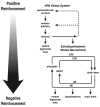The role of CRF and CRF-related peptides in the dark side of addiction
- PMID: 19912996
- PMCID: PMC2819562
- DOI: 10.1016/j.brainres.2009.11.008
The role of CRF and CRF-related peptides in the dark side of addiction
Abstract
Drug addiction is a chronically relapsing disorder characterized by a compulsion to seek and take drugs, the development of dependence, and the manifestation of a negative emotional state when the drug is removed. Activation of brain stress systems is hypothesized to be a key element of the negative emotional state produced by dependence that drives drug-seeking through negative reinforcement mechanisms, defined as the "dark side" of addiction. The focus of the present review is on the role of corticotropin-releasing factor (CRF) and CRF-related peptides in the dark side of addiction. CRF is a key mediator of the hormonal, autonomic, and behavior responses to stressors. Emphasis is placed on the role of CRF in extrahypothalamic systems in the extended amygdala, including the central nucleus of the amygdala, bed nucleus of the stria terminalis, and a transition area in the shell of the nucleus accumbens, in the dark side of addiction. The urocortin/CRF(2) systems have been less explored, but results suggest their role in the neuroadaptation associated with chronic drug use, sometimes in opposition to the effects produced by the CRF(1) receptor. Compelling evidence argues that the CRF stress system, including its activation of the hypothalamic-pituitary-adrenal axis, plays a key role in engaging the transition to dependence and maintaining dependence once it is initiated. Understanding the role of the CRF systems in addiction not only provides insight into the neurobiology of the dark side of addiction, but also provides novel targets for identifying vulnerability to addiction and the treatment of addiction.
Copyright 2009 Elsevier B.V. All rights reserved.
Figures



References
-
- Alheid GF, Heimer L. New perspectives in basal forebrain organization of special relevance for neuropsychiatric disorders: the striatopallidal, amygdaloid, and corticopetal components of substantia innominata. Neuroscience. 1988;27:1–39. - PubMed
-
- Alling C, Balldin J, Bokstrom K, Gottfries CG, Karlsson I, Langstrom G. Studies on duration of a late recovery period after chronic abuse of ethanol: a cross-sectional study of biochemical and psychiatric indicators. Acta Psychiatr Scand. 1982;66:384–397. - PubMed
-
- Annis HM, Sklar SM, Moser AE. Gender in relation to relapse crisis situations, coping, and outcome among treated alcoholics. Addict Behav. 1998;23:127–131. - PubMed
-
- Aston-Jones G, Delfs JM, Druhan J, Zhu Y. The bed nucleus of the stria terminalis: a target site for noradrenergic actions in opiate withdrawal. In: McGinty JF, editor. Advancing from the Ventral Striatum to the Extended Amygdala: Implications for Neuropsychiatry and Drug Abuse. Vol. 877. New York Academy of Sciences; New York: 1999. pp. 486–498. series title: Annals of the New York Academy of Sciences. - PubMed
-
- Bachtell RK, Tsivkovskaia NO, Ryabinin AE. Strain differences in urocortin expression in the Edinger-Westphal nucleus and its relation to alcohol-induced hypothermia. Neuroscience. 2002;113:421–434. - PubMed
Publication types
MeSH terms
Substances
Grants and funding
LinkOut - more resources
Full Text Sources
Medical
Molecular Biology Databases

